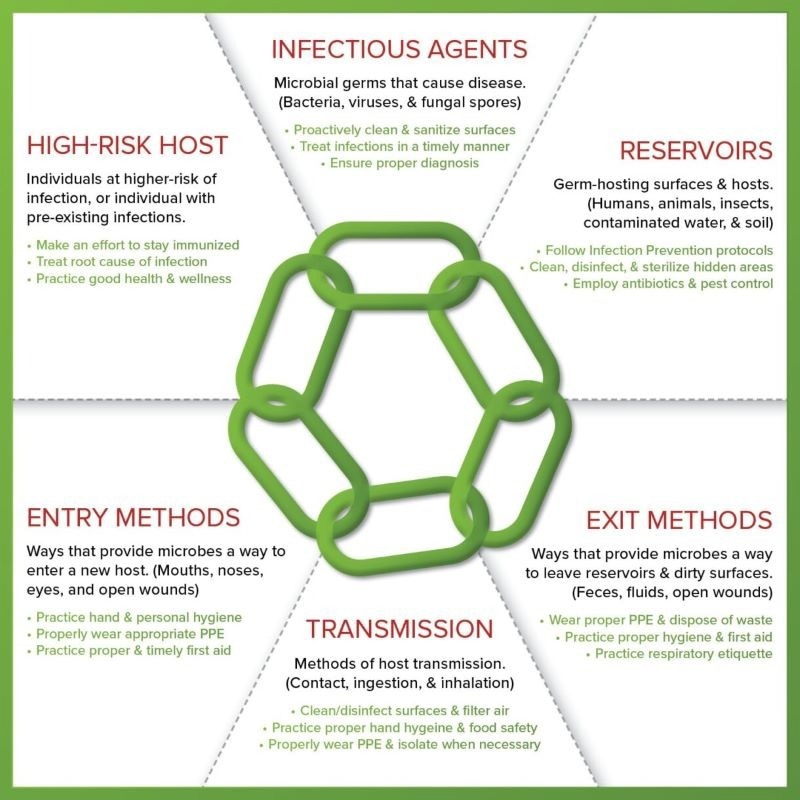Diseases rely on living organisms to survive and move between hosts via various contamination methods, such as airborne, contact, and liquid.
Stopping infections might seem impossible, but it is quite simple. Every organism has six “links” upon which the chain of infection can be broken; breaking any link helps to ensure microbial safety.
The chain’s six links include:
- Infectious agent: The microbe—bacteria, virus, parasite, or fungus—causing disease.
- Reservoir: The microbe’s required habitat to live and multiply, e.g. humans, animals, environments
- Method of exit: How a microbe escapes its reservoir, e.g. cough, open wound, sneeze
- Method of spread: How a microbe travels host to host, e.g. airborne, contact, droplet
- Method of entry: How a microbe enters a new host, e.g. broken skin, eyes, mouth, nose
- Susceptible host: Everyone, particularly the chronically ill, intubated, immunocompromised, or malnourished
Identifying and targeting infectious agents
Detecting the specific organism—or infectious agent—contaminating a space is crucial in any environment, particularly healthcare. Distinct microorganisms necessitate specific cleaning and decontamination methods to be effectively eradicated and some are more resilient against extermination than others.
To break this link, specifically target each microorganism for accurate eradication. Select the best disinfectant, allow for adequate contact time, and use PPE to decrease disease transmission, safeguard patients and healthcare workers, and enhance patient outcomes.
Managing reservoirs of microbial growth
The area where an organism resides and reproduces is its reservoir. Environments host many microbes, but humans and animals are also threatened.
Humans are living beings with their own microbial ecosystems and provide hospitable temperatures, moisture, and contact with surfaces that offer optimum conditions for microbes to replicate and develop.
Animals are similar and also attract zoonotic illnesses. Neighboring surroundings can also host organisms that resist environmental conditions.
To break this link, hard-to-reach spaces should be cleaned with sufficient sanitizing methods, eliminating possible causes of bacteria—food, soil, biomass, blood, and more—from the region to stop the microbial spread via every transmission method.
Controlling microbial exit points
After establishing a reservoir, microbes leave to infect a new host via familiar methods such as coughing, sneezing, or open wounds.
An infected individual coughing or sneezing fills the air with pathogen-laden droplets that others can inhale. Open wounds also promote spread via direct contact with the wound or other contaminated items.
To break this link, be conscious of others and prevent microbes from infecting the environment. When sneezing or coughing, use a tissue or your inner elbow to inhibit airborne and contact transmission. Clean and cover open wounds appropriately to prevent others from encountering leaking fluid or the wound itself.
Reducing transmission risks in daily interactions
Microbes are transmitted via droplets, airborne, and direct contact. When an infected host sneezes or coughs, spray and splash droplets transmit microbes to a new host. These droplets and other harmful microbes can also remain airborne, facilitating transmission when air currents or stagnant air carry microbes.
Unsafe microbes like MRSA or VRE can be transmitted to a new host through direct contact when a contaminated host touches a surface or another possible host.
To break this link, implement comprehensive hygiene practices. Handle food correctly, promptly clean and cover wounds, wash hands for 20 seconds after touching contaminated surfaces, and do not share personal hygiene and items.
Understand infection routes, particularly in healthcare environments. These routes include people, dry surfaces, such as bed rails and medical equipment, and surfaces that could hold biofilms, such as toilets and taps.
Preventing microbial entry into hosts
The same methods of exit, eyes, mouth, nose, and broken skin, are also methods of entry. If a microorganism can enter an opening through air, droplet, or direct contact, a disease, spore, or pathogen can effectively spread and reproduce in a new atmosphere to repeat the infection cycle.
To break this link, understand entry methods. Inhaling particles, ingesting contaminated water or food, and contact with contaminated individuals, animals, and insects are all avenues that can cause diseases. Prepare food correctly, avoid others when infection is present, and regularly clean surfaces.
Protecting vulnerable populations from infection
Vulnerable hosts, including those receiving healthcare and those with compromised immune systems (e.g. chemotherapy/transplant patients), are fragile and have greater infectivity.
Those with invasive medical devices—catheters, breathing tubes, or artificial joints—have a greater infection risk as these devices can serve as entry points for microbes.
To break this link, recognize and safeguard high-risk hosts, providing a clean environment to inhibit the spread of healthcare-associated infections and enhance patient outcomes.
Disinfection as a key defense against pathogens
Research indicates that, on average, we touch 300 surfaces daily that are home to harmful germs, including door handles, light switches, worktops, etc. Frequently sanitizing these spaces is critical for preventing diseases like C. difficile, norovirus, and more.
Prioritizing environmental cleanliness and following advised cleaning methods can substantially lower the spread of harmful pathogens, defend ourselves and others, and promote a healthier community.
One disinfection can weaken every link in the infection chain. The sophisticated, wide-ranging decontamination of SteraMist—among other effective solutions—is essential to establishing cleaner environments.
SteraMist’s iHP technology eradicates airborne molecules and sterilizes critical equipment to provide cleaner environments for infected individuals. It delivers highly compatible decontamination to any use site.

Image Credit: SteraMist Disinfection and Decontamination Technology
About SteraMist Disinfection and Decontamination Technology
SteraMist is a global line of powerful disinfection and decontamination products and services that utilizes patented ionized Hydrogen Peroxide (iHP) technology.
Our scientific expertise, innovation, and dedication to creating a safer world through cutting-edge iHP technology allow SteraMist to serve our customers and industries with trusted products, leading to a smarter way to decontaminate and control infectious diseases.
Sponsored Content Policy: News-Medical.net publishes articles and related content that may be derived from sources where we have existing commercial relationships, provided such content adds value to the core editorial ethos of News-Medical.Net which is to educate and inform site visitors interested in medical research, science, medical devices and treatments.